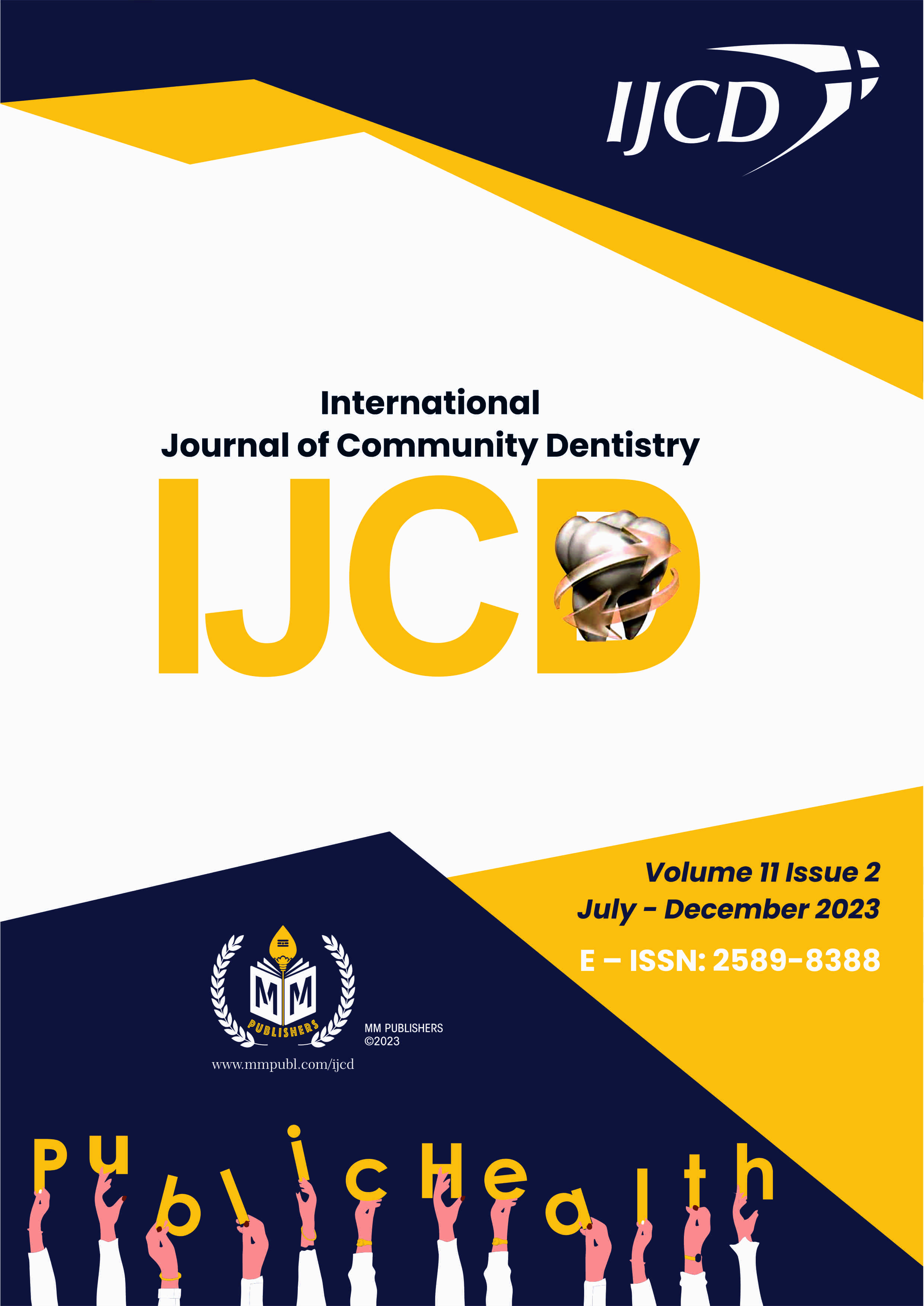Comparative evaluation of anti-bacterial effect of Caesalpinia sappan aqueous extract and 0.12% Chlorhexidine against Streptococcus mutans – An in vitro study
Original Article
DOI:
https://doi.org/10.56501/intjcommunitydent.v11i2.867Keywords:
Pathimugam, Antibacterial activity, C. Sappan wood, Caries preventionAbstract
Aim and objectives: To evaluate and compare the antimicrobial activity of various concentration of C.sappan wood aqueous extract (100mg/ml, 200mg/ml, 300mg/ml, 400mg/ml, 500mg/ml and 600mg/ml) and 0.12% chlorhexidine mouthwash using agar well diffusion method against St.mutans.
Materials and Methods: A comparative experimental invitro study was conducted to evaluate and compare antimicrobial activity of various concentration of C.Sappan aqueous extract and 0.12% Chlorhexidine. The study enclosed extract of 100mg/ml, 200mg/ml, 300mg/ml, 400mg/ml, 500mg/ml, 600mg/ml and 0.12% Chlorhexidine as control. The antimicrobial activity was assessed by agar well diffusion method, were 50µl of each concentration was poured in the prepared agar well and assessed for zone of inhibition.
Results: The antimicrobial potential of test compounds was estimated by measuring the zone of inhibition and all the procedure are done in triplicates and values are assessed using One way ANOVA and Post Hoc analysis. All the concentration used showed zone of inhibition against St.mutans. At the concentration, 600mg/ml of aqueous C.sappan extract have a larger zone of inhibition (22.41±.32). In agar well diffusion method, at the minimal concentration of 600mg/ml and C.Sappan aqueous extract was comparatively better than positive control group (0.12%cholorhexidine).
Conclusion: C.Sappan wood aqueous extract could be preferred for routine oral hygiene practice where it can provide maximal antimicrobial effect without side effects of routine aid.
References
Department of Human Services. Promoting oral health 2000–2004: strategic directions and framework for action. Melbourne: Department of Human Services; 1999.
Listl S, Galloway J, Mossey PA, Marcenes W. Global economic impact of dental diseases. J Dent Res. 2015; 94:1355-1361.
Mealey BL, Oates TW. American Academy of Periodontology. Diabetes mellitus and periodontal diseases. J Periodontol 2006; 77:1289‑303.
Krzyściak, W., Jurczak, A., Kościelniak, D. et al. The virulence of Streptococcus mutans and the ability to form biofilms. Eur J Clin Microbiol Infect Dis 33, 499–515 (2014).
Selwitz RH, Ismail AI, Pitts NB. Dental caries. The Lancet. 2007 Jan 6;369(9555):51-9.
Addy M. Plaque control as a scientific basis for the prevention of dental caries. Journal of the Royal Society of Medicine. 1986;79(Suppl 14):6.
Rao NJ, Subash KR, Kumar KS. Role of phytotherapy in gingivitis: A review. Int J Pharmacol. 2012; 1:1-5
Zanatta FB, Antoniazzi RP, Rösing CK. Staining and calculus formation after 0.12% chlorhexidine rinses in plaque-free and plaque covered surfaces: a randomized trial. J Appl Oral Sci. 2010 Sep-Oct;18(5):515-21
Saenjum C, Chaiyavat C, Kadchumsang S, Chansakaow S, Suttajit M. Antioxidant activity and protective effects on DNA damage of Caesalpinia sappan L. extract. J Med Plant Res 2010; 4: 1594-608.
Mueller M, Weinmann D, Toegel S, Holzer W, Unger FM, Viernstein H. Compounds from Caesalpinia sappan with anti-inflammatory properties in macrophages and chondrocytes. Food Funct. 2016 Mar;7(3):1671-9.
Arunkumar Naik Bukke, Fathima Nazneen Hadi, Chandramati Shankar Produtur, Comparative study of in vitro antibacterial activity of leaves, bark, heart wood and seed extracts of Caesalpinia sappan L., Asian Pacific Journal of Tropical Disease, Volume 5, Issue 11, 2015, Pages 903-907.
Sahal D. Evaluation of Antimalarial Potential of Kerala Ayurvedic Water “Pathimugam. Available at SSRN 4124886.
CLSI, Methods for Antimicrobial Dilution and Disk Susceptibility of Infrequently Isolated or Fastidious Bacteria, Approved Guideline, 2nd. ed., CLSI document M45-A2. Clinical and Laboratory Standards Institute, 950 West Valley Roadn Suite 2500, Wayne, Pennsylvania 19087, USA, 2010.
Nirmal NP, Rajput MS, Prasad RG, Ahmad M. Brazilin from Caesalpinia sappan heartwood and its pharmacological activities: A review. Asian Pac J Trop Med. 2015 Jun;8(6):421-30.
Thomas G, John AM, Joy J, Mathew SS, David A.Impact of taking thyroxine with herbal brews. J Curr Res Sci Med 2018;4:94-7.
https://www.who.int/news-room/fact-sheets/detail/oral-health.cited on 11.06.2023.
Venditti M, Baiocchi P, Santini C, Brandimarte C, Serra P, Gentile G, Girmenia C, Martino P. Antimicrobial susceptibilities of Streptococcus species that cause septicemia in neutropenic patients. Antimicrob Agents Chemother. 1989 Apr;33(4):580-2. doi: 10.1128/AAC.33.4.580.
Yim NH, Jung YP, Cho WK, Kim T, Kim A, Im M, Ma JY. Screening of aqueous extracts of medicinal herbs for antimicrobial activity against oral bacteria. Integr Med Res. 2013 Mar;2(1):18-24.
Puttipan R, Wanachantararak P, Khongkhunthian S, Okonogi S. Effects of Caesalpinia sappan on pathogenic bacteria causing dental caries and gingivitis. Drug Discov Ther. 2017;11(6):316-322.
Yodsaoue O, Cheenpracha S, Karalai C, Ponglimanont C, Tewtrakul S. Anti-allergic activity of principles from the roots and heartwood of Caesalpinia sappan on antigen-induced beta-hexosaminidase release. Phytother Res. 2009 Jul;23(7):1028-31.
Budi HS, Soesilowati P, Wirasti MJ. Antibacterial activity of sappan wood (Caesalpinia sappan L.) against aggregatibacter actinomycetemcomitans and porphyromonas gingivalis. Systematic Reviews in Pharmacy. 2020;11(3):349-353.
Senthilkumar, Natesan, Subban Murugesan, N. R. L. Banu, Sultan Supriya and C. Rajeshkannan. “Biochemical Estimation and Antimicrobial Activities of the Extracts of Caesalpinia Sappan Linn.” Bangladesh Journal of Scientific and Industrial Research 46 (2012): 429-436.

Downloads
Published
How to Cite
Issue
Section
License
Copyright (c) 2023 Madhivathani S M, Umesh K, Sangeeta Chavan, Palanivel Pandian R, Prem Kumar P

This work is licensed under a Creative Commons Attribution-NonCommercial 4.0 International License.



